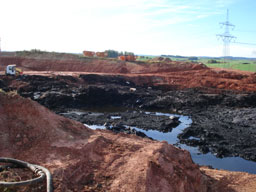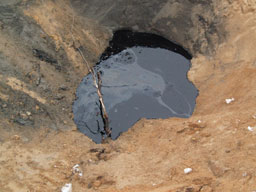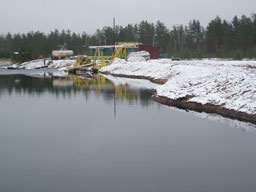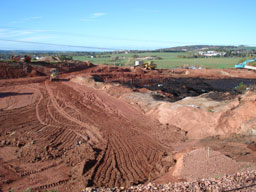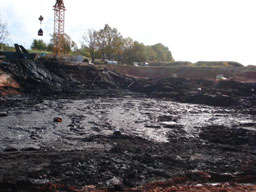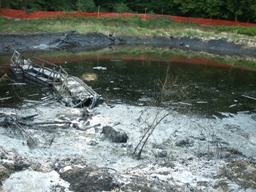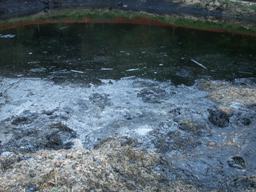There are waste deposits all around the world, containing sulphuric acid. They were created after oil products proceeding using concentrated sulphuric acid and mostly during waste oils refining. These so called acid gums and acid tars due to lack of possibility of removing and recovering most often were deposited in open deposits (acid-gum ponds), sometimes their amount exceeded 100,000 t. Black, gum-looking substance along with a large amount of polymerized carbohydrates (gums) contains also residues of oils and additives, and sulphuric acid (up to 45% of volume depending on previously used industrial processes). These deposits are very hazardous for environment. Open acid-tar ponds are hazardous due to following reasons:
|

|
Pertinent hazard of over filling and large-scale nature contamination;
|
|

|
Non-stability of existing dikes;
|
|

|
Water leakage into dikes, their foundations and ground waters;
|
|

|
Contamination of surface, filtration and ground waters;
|
|

|
A high possibility of ignition;
|
|
|
Open water spaces attract birds and mammals that die after contact with ponds environment. Open ponds evolve gases, that even in still condition produce stinking smells, especially in summer.
|
In order to perform ecological recovery of acid tar ponds, CORVUS Company has developed and prepared for implementation new technologies of acid tars taking out and processing for further energetic processing.
Latvian media has written several times about the environmental hazard of acid tar deposits in Inchukalns (Northern and Southern ponds). The Southern pond is especially hazardous, because it's open for impact from the atmosphere and has stratified layers in its depth. The area of the Southern pond is 1.6 ha. The amount of waste in the pond constitutes approximately 64 thousands m3. The mass is divided by layers as follows: surface water layer, contaminated with light fractions of oil products, is approximately 16 thousands m3; fluent middle layer (mainly acid tar) constitutes approximately 10 thousands m3 and the last layer – tar and ground mixture constitutes approximately 13 thousands m 3.
These deposits are so hazardous, that in 1996 an agreement was made on including the object in Inchukalns by EEK UNO in primary objects list, contaminated by chemical industry, and needing recovery in the scale of Eastern and Central Europe.
The main problem of pond liquidation is neutralizing its components, respectively, acid tar, that are so aggressive, that even the pump details, made of stainless steel, are completely destroyed after several months of use.
The second problem is a necessity to perform primary processing of fluent tar layer without touching the upper water layer. The surface layer is produced by rainfall, so its removal before the fluent middle layer processing is not efficient, because the upper layer shall grow again. And the water layer partially protects the tar layer of vaporization in summer and thus helps to eliminate air contamination.
Our company is involved in oil waste collection, recovery and fuel preparation from oil waste, and oil tanks cleaning from oil products since its foundation.
This experience allowed us to develop a system of acid tad neutralization (its two upper layers) in Southern pond, taking into consideration the above mentioned problems.
|






























